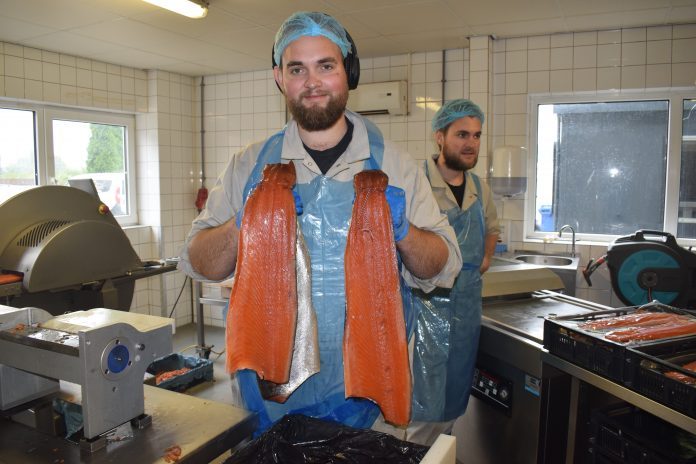Sognefjord is an unusual name for a Dutch salmon smokehouse. But in this case it makes complete sense, because owner Peter-Anton Peters is a Norwegian citizen with Dutch roots.
“I was born in the Netherlands, but my parents moved to Norway when I was eight. I grew up in Norway, in Haugesund, between Bergen and Stavanger, and have lived there for most of my life,” Peters told Salmon Business.

He worked for several Norwegian export companies for a long time, selling salmon to customers all over the world. “That is how and where my fascination with salmon started. I worked 25 years in that field, even after I moved back to the Netherlands.”
Peters’ return to his country of birth was in 2000 – “I remained Dutch in my heart, in spite of all those years in Norway, and decided to return to the Netherlands with my family. At that time I was ready for a change.”
Three star chef
In 2010 Peters decided to start a small-scale salmon smokehouse, focusing on quality products.
“I named my company Sognefjord zalm, after the longest and most beautiful fjord in Norway. The salmon we smoke is mainly from that area.”
 Peters started experimenting with salmon smoking, a skill he learned at different smokehouses. When he was happy with the result, he took a few samples to De Librije in Zwolle, a three star restaurant, owned by famous Dutch chef Jonnie Boer.
Peters started experimenting with salmon smoking, a skill he learned at different smokehouses. When he was happy with the result, he took a few samples to De Librije in Zwolle, a three star restaurant, owned by famous Dutch chef Jonnie Boer.
 “Jonnie Boer was very enthusiastic about the taste and the quality. With his recommendation I found a lot of clients among other restaurants all over the country, and my business grew rapidly.”
“Jonnie Boer was very enthusiastic about the taste and the quality. With his recommendation I found a lot of clients among other restaurants all over the country, and my business grew rapidly.”
Family business
He soon moved to the more centrally located city of Nijmegen, where he opened a larger smoking facility.
His two sons, Mads Vincent and Martin, then joined the family business, and now they do most of the handwork. Peter-Anton Peters handles administration, purchasing and sales.
“We focus on quality and that’s how we distinguish ourselves from other smokehouses. We smoke our salmon hung by the tail, to lose as much moisture as possible. That way our product is dryer and gets its characteristic taste.”
The salmon, collected in Norway on Friday, is transported immediately to Urk for filleting at the Dutch Seafood Company, from whence it is delivered early Monday morning at Sognefjord.
Ancient Viking technique
The smoking process consists of dry salting for eight hours, then drying for 12 hours and, most importantly, the smoking, for another 12 hours. Peters uses oak, beech wood and three other kinds of wood for smoking, with a very special finishing touch; juniper bush.

“An ancient Norwegian smoking technique, already used by the Vikings,” Peters explains. “During the last two hours of the smoking process, we add juniper to the wood. It gives our smoked salmon its distinctive taste and a longer shelf life. We are the only company in the Netherlands using this technique. The Vikings used this technique to preserve their fish and meat for their long sea voyages.”
Juniper bush
Peters and his sons visit Norway every two months to collect juniper bushes. “They grow in the wild in Norway, along the coasts.”
Sognefjord mostly delivers directly to restaurants.
 “That way we are able to keep our prices stable, in spite of the changing market price of the salmon from Norway,” Peters explains.
“That way we are able to keep our prices stable, in spite of the changing market price of the salmon from Norway,” Peters explains.
“Our customers always pay the same price, and know they can rely on that. Because our margin is reasonably big, we could handle the higher purchase price of salmon by decreasing our own margin and looking for extra customers.”
Now that the salmon prices are decreasing, his margins are increasing again, explains Peters. “The growth conditions in Norway are ideal right now. Because of the perfect water temperature the fish grow about 200 grams a week. That increase in biomass, combined with the quieter period in Europe because of the summer vacation and the set-back in demand from southern European supermarkets, has caused the recent decrease in salmon prices. Less demand than offer: classical market story.”
He is quite happy with the recent higher salmon production in Norway.
“We’ll enjoy having lower prices and better margins as long as we can. It won’t last long anyway, because in September the big smokehouses will start producing for Christmas, so demand will increase again.”
Small scale
Sognefjord produces 2000 salmon sides per week.
 “We prefer to keep it at this size, which we can handle with the three of us, and still maintain our high quality standards.”
“We prefer to keep it at this size, which we can handle with the three of us, and still maintain our high quality standards.”
“We will never be a big company, but we are an important player in the upper restaurant segment,” he adds with a smile.

